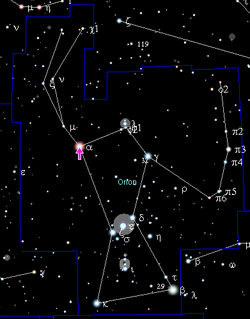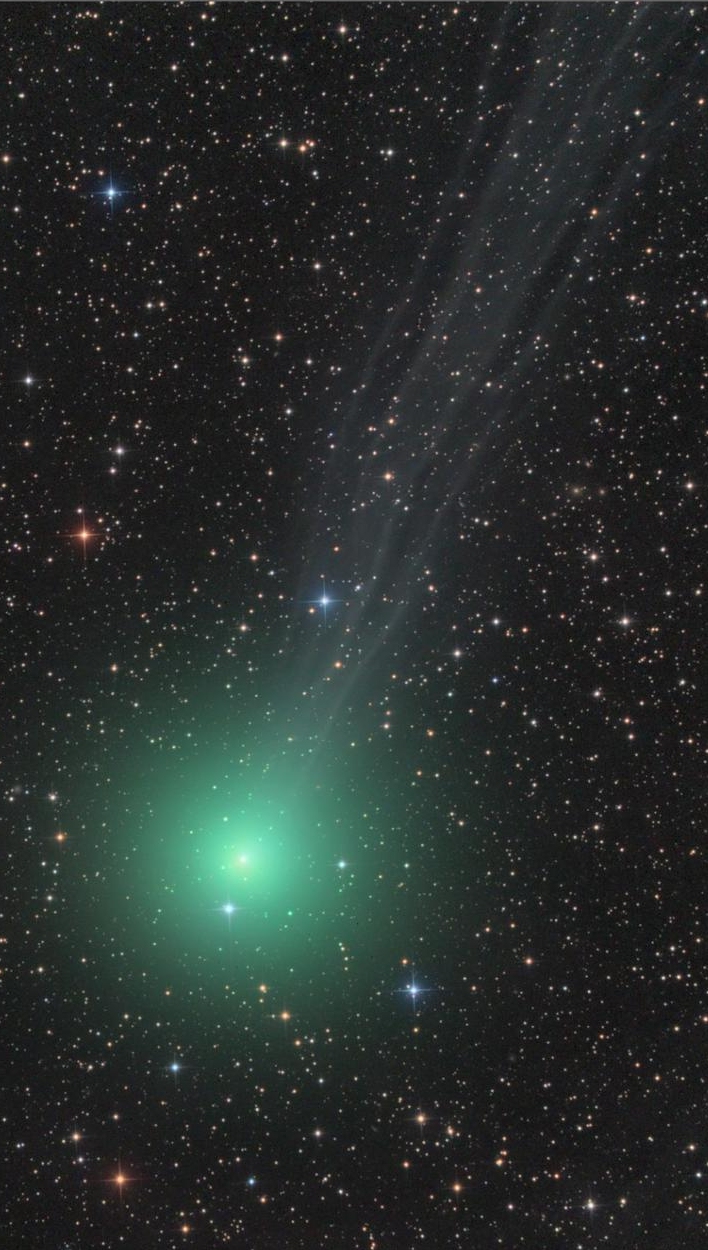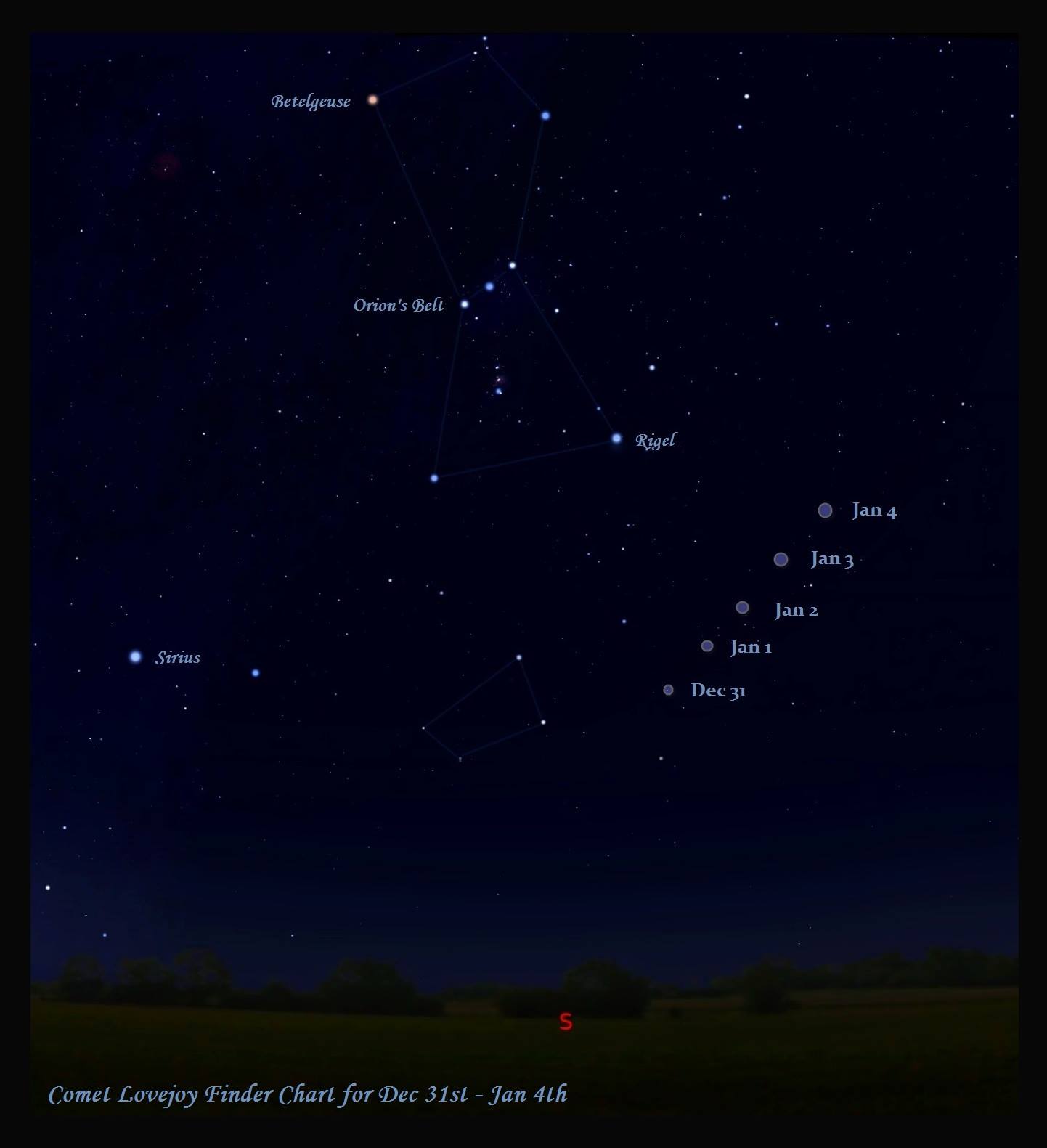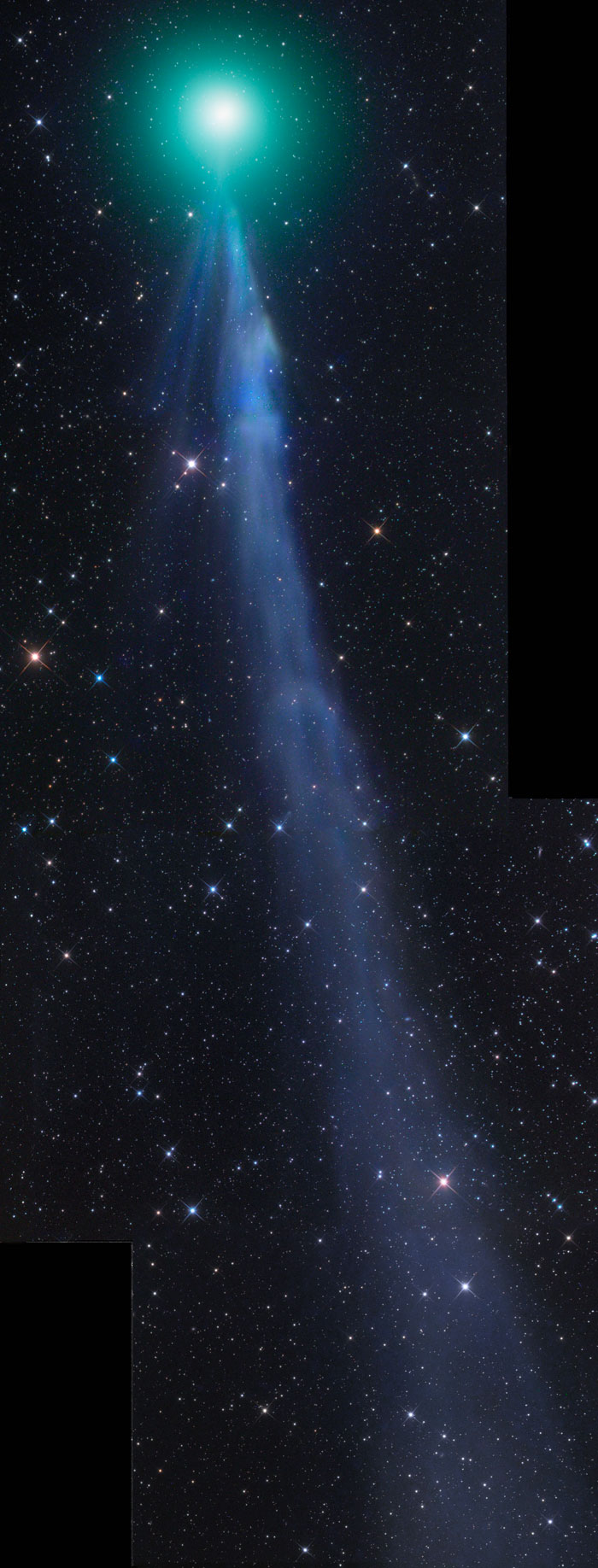It looks like you're using an Ad Blocker.
Please white-list or disable AboveTopSecret.com in your ad-blocking tool.
Thank you.
Some features of ATS will be disabled while you continue to use an ad-blocker.
share:
"Comets are basically like cats, a senior researcher at Johns Hopkins University tells the Christian Science Monitor: "They're very interesting, and they do what they want." That may explain that even though scientists didn't think Comet C/2014 Q2 (also known as Comet Lovejoy) would prove to be visible to the human eye when it was discovered back in August, it now will be to viewers in non-light-polluted areas, thanks to the unpredictability of comet brightness.
Peak viewing times will be in mid-January, the Monitor notes, with the comet appearing to the right of the bottom half of Orion's bow on Jan. 7—the day the comet will come closest to Earth at 44 million miles.
There won't be an encore performance in our lifetime, either: The comet isn't scheduled to loop around this way for another 8,000 years. The comet was discovered over the summer by Australian astronomer Terry Lovejoy, who employed nothing more than a simple backyard telescope with an 8-inch mirror, National Geographic reports."
www.foxnews.com...
Almost forgot about this comet. Most people can spot Orion by its unique 3 star belt and Betelgeuse,which is the 9th brightest star.
The full moon is on the 5th. so it might obscure the comet a bit,Get outside and get out your scope or binoculars if you have them. Clear skys!
According to the article' the comet should be visible until the end of the month.

edit on 1/3/2015 by mugger because: add
edit on 1/3/2015 by FlyersFan because: (no reason given)
a reply to: mugger
Dude, today's been a super-weird day for synchonicity for me. This spring or summer, I had a dream about a huge meteor shower of glowing green, right above where I live. A few nights ago, maybe New Years Eve, I was looking at Orion (just the easiest for me to spot where I live now), and really wondering if the green comet would intersect it.
I think yesterday was when I saw a snap of Lovejoy. media2.s-nbcnews.com... Glowing a lovely green right now.
And now you've put it all together for me! Thanks for posting this, I will be outside all bundled up for certain!
Dude, today's been a super-weird day for synchonicity for me. This spring or summer, I had a dream about a huge meteor shower of glowing green, right above where I live. A few nights ago, maybe New Years Eve, I was looking at Orion (just the easiest for me to spot where I live now), and really wondering if the green comet would intersect it.
I think yesterday was when I saw a snap of Lovejoy. media2.s-nbcnews.com... Glowing a lovely green right now.
And now you've put it all together for me! Thanks for posting this, I will be outside all bundled up for certain!
Watching the sky is far greater source of entertainment for me than anything on television.
Spend some time with it. You will see wonders.
Spend some time with it. You will see wonders.
It is an exciting opportunity to spot a comet (especially if you have never done so before)!
If you have dark skies, you can already see this comet with the nake eye. From urban locations, you can easily find it in binoculars, provided there's no fog or strong light pollution spoiling the view.
I have a thread here - Comets in the sky right now where you can find some great images and additional information about this comet.


A few points of note:
1. If you think it's either a telescope (which not everybody can afford or want to get involved with) or your own eyes, you're wrong. Binoculars are fairly affordable, easy to use, and offer decent magnification and light-gathering capability for many celestial objects. With binoculars, you will see numerous star clusters, the Andromeda galaxy, the Orion nebula, craters and mountains on the Moon, Jupiter's Galileian moons, Uranus, and, of course, comets. While prominent naked-eye comets are few and far in-between, binocular comets can be observed practically every year. Using binoculars is also good to learn your way around the night sky, "star-hopping" from star to star to find objects of interes. Every stargazer should have a pair of binoculars.
2. While comets look glorious in photos, what you will see in binoculars will look like a fuzzy blob of light, with hardly any colour or tail visible. Try not to be disappointed, as photographs usually require minutes or hours of exposure, and lots of post-processing to make them look so pretty. Human eyesight is not that great in low-light. Still, the fact that you are looking at a real comet (or a galaxy, or a nebula) with your own eyes, is what counts.
If you have dark skies, you can already see this comet with the nake eye. From urban locations, you can easily find it in binoculars, provided there's no fog or strong light pollution spoiling the view.
I have a thread here - Comets in the sky right now where you can find some great images and additional information about this comet.


A few points of note:
1. If you think it's either a telescope (which not everybody can afford or want to get involved with) or your own eyes, you're wrong. Binoculars are fairly affordable, easy to use, and offer decent magnification and light-gathering capability for many celestial objects. With binoculars, you will see numerous star clusters, the Andromeda galaxy, the Orion nebula, craters and mountains on the Moon, Jupiter's Galileian moons, Uranus, and, of course, comets. While prominent naked-eye comets are few and far in-between, binocular comets can be observed practically every year. Using binoculars is also good to learn your way around the night sky, "star-hopping" from star to star to find objects of interes. Every stargazer should have a pair of binoculars.
2. While comets look glorious in photos, what you will see in binoculars will look like a fuzzy blob of light, with hardly any colour or tail visible. Try not to be disappointed, as photographs usually require minutes or hours of exposure, and lots of post-processing to make them look so pretty. Human eyesight is not that great in low-light. Still, the fact that you are looking at a real comet (or a galaxy, or a nebula) with your own eyes, is what counts.
edit on 3-1-2015 by wildespace because: (no reason given)
a reply to: wildespace
Great post! Hopefully the weather cooperates for me, cloudy now and missing the current meteor shower
Great post! Hopefully the weather cooperates for me, cloudy now and missing the current meteor shower
I was reading about this comet the other day and am looking forward to possibly sewing it. .....I wonder where " cheesey " is? He usually is all
about posting in comets..... Anyone heard from cheesey?
Probably the most beautiful comet I've ever seen.

Photo by Gerald Rhemann.
The almost full Moon is spoiling it somewhat, but provided the sky stays relatively clear, I'm gonna try spotting it again.
Who thought that looking at a small and faint foggy patch of light could be so exciting?

Photo by Gerald Rhemann.
The almost full Moon is spoiling it somewhat, but provided the sky stays relatively clear, I'm gonna try spotting it again.
Who thought that looking at a small and faint foggy patch of light could be so exciting?
edit on 3-1-2015 by wildespace because: (no
reason given)
WE'RE ALL GONNA DIE!
Right? I mean where are the doomsayers on such a JUICY target anyway?
Gettin LAZY people.
Right? I mean where are the doomsayers on such a JUICY target anyway?
Gettin LAZY people.
Been overcast and rainy here for....days and days.....
Won't be able to see anything for the next several days either according to the weather.
Typical for late fall, early winter here where I live.
Get's better later in January and Feb. Skies clear up and get very crisp looking.
Won't be able to see anything for the next several days either according to the weather.
Typical for late fall, early winter here where I live.
Get's better later in January and Feb. Skies clear up and get very crisp looking.
I just got a new telescope for christmas. I can't wait for a clear/mild night to get out and see this beauty.
Good timing that's for sure
Good timing that's for sure
originally posted by: wildespace
1. If you think it's either a telescope (which not everybody can afford or want to get involved with) or your own eyes, you're wrong. Binoculars are fairly affordable, easy to use, and offer decent magnification and light-gathering capability for many celestial objects. With binoculars, you will see numerous star clusters, the Andromeda galaxy, the Orion nebula, craters and mountains on the Moon, Jupiter's Galileian moons, Uranus, and, of course, comets. While prominent naked-eye comets are few and far in-between, binocular comets can be observed practically every year. Using binoculars is also good to learn your way around the night sky, "star-hopping" from star to star to find objects of interes. Every stargazer should have a pair of binoculars.
Very good points.
I have a pair of binoculars that cost £50 and they are superb - good enough to see Jupiter's Galilean moons on a very clear night, just about see the solar panels on the ISS, and the moon always looks amazing.
I also have a scope, but very little opportunity to use it given a) the faff of setting it up and b) my location - light pollution and other houses make viewing difficult. My binoculars are a great standby to quickly look at things. I'm considering getting a tabletop scope for quick viewing - I had use of one a while ago that was good enough to see Jupiter's bands.
It's also worth checking your local amateur astronomy clubs out - I have one near me that has a proper observatory set up that is free to members or a small fee to casual visitors.
Your other point about disappointment is also important - we're all used to seeing spectacular images from high end scopes and probes and seeing little fuzzy blobs can be deflating. However you can't beat seeing Jupiter properly for the first time, or when you get to see the moon as a genuine 3D object instead of a flat circle.
I'm annoyed I did't spot this thread earlier - skies have been very clear by me for a few days now and Orion has been very obvious from my garden!
originally posted by: wildespace
It is an exciting opportunity to spot a comet (especially if you have never done so before)!
If you have dark skies, you can already see this comet with the nake eye. From urban locations, you can easily find it in binoculars, provided there's no fog or strong light pollution spoiling the view.
I have a thread here - Comets in the sky right now where you can find some great images and additional information about this comet.
A few points of note:
1. If you think it's either a telescope (which not everybody can afford or want to get involved with) or your own eyes, you're wrong. Binoculars are fairly affordable, easy to use, and offer decent magnification and light-gathering capability for many celestial objects. With binoculars, you will see numerous star clusters, the Andromeda galaxy, the Orion nebula, craters and mountains on the Moon, Jupiter's Galileian moons, Uranus, and, of course, comets. While prominent naked-eye comets are few and far in-between, binocular comets can be observed practically every year. Using binoculars is also good to learn your way around the night sky, "star-hopping" from star to star to find objects of interes. Every stargazer should have a pair of binoculars.
2. While comets look glorious in photos, what you will see in binoculars will look like a fuzzy blob of light, with hardly any colour or tail visible. Try not to be disappointed, as photographs usually require minutes or hours of exposure, and lots of post-processing to make them look so pretty. Human eyesight is not that great in low-light. Still, the fact that you are looking at a real comet (or a galaxy, or a nebula) with your own eyes, is what counts.
It's something I've always wanted to do, but never knew where to start.
Like, what sort of telescope is needed?
And you say binoculars..can you give some examples of both binoculars and telescopes that would be appropriate, not just for this comet, but in general?
originally posted by: mortex
It's something I've always wanted to do, but never knew where to start.
Like, what sort of telescope is needed?
And you say binoculars..can you give some examples of both binoculars and telescopes that would be appropriate, not just for this comet, but in general?
I have a pair of Helios Fieldmaster 12*50 binoculars (£50 when I bought them a couple of years ago). You can get larger ones but they start to become heavy and difficult to use without a mount.
You can pick up decent telescopes new for £150-£200, but you need to also factor in extras like different strength eyepieces and barlow lenses (additional lenses that multiply the magnification by 2 or 3 times). Like any specialist hobby there are budget and expensive options but even with budget ones lots of cheap things add up to a lot! My telescope cost £200 but I probably spent as much as that again on extra bits (I wanted to take photographs, so a lot of the extras were for that).
If you can afford it, get one with a motor that allows you to track objects (in other words they stay on view while the Earth rotates), and if you have a bit more get one with a 'go to'' mount - even large objects like the moon can be surprisingly difficult to get in view.
originally posted by: mortex
It's something I've always wanted to do, but never knew where to start.
Like, what sort of telescope is needed?
And you say binoculars..can you give some examples of both binoculars and telescopes that would be appropriate, not just for this comet, but in general?
Actually, I don't own a telescope, so can't offer much advice other than: the larger the main mirror or lens - the better. A cheap skinny retail store telescope that boats something like x1000 magnification will be a big disappointment.
As for binoculars, 10x50 is considered a good standard for stargazing. (the first number means magnification, the second number means the objective diameter) I have 10x42 binos, they are fairly decent and lightweight. There are larger binos, like 15x70, but they are heavy and you'll get a shaky image unless you put them on a tripod.
Just Google "astronomy binoculars" and you'll find lots of guides and tips. For example: www.skyandtelescope.com...
I suggest getting binoculars before the telescope. That way, you'll get used to finding your way around the night sky, learn to "tease out" the faint detail, and appreciate what you can see. Then, with a telescope, you'll feel more confident using it, and more appreciative of the extra detail offered by it. Those are just my thoughts, mind you, it's up to you.
~~~
[Edit] I'll include another advantage to using binoculars.
Using two eyes instead of one for stargazing is better in several respects, even if it doesn't give you the perception of depth because of the immense distances involved:
1. It feels more comfortable and natural.
2. Human low-light vision is "noisy", but using both eyes cancels this "noise" out, giving a much smoother image with better acuity to faint details and structure. This helps seeing the very faint objects, or seeing the subtle detail in nebulae.
3. You get a wider field of view at the same magnification, making it easier to find objects of interest, and give them a context.
Read more here: www.brucesayre.net...
Lastly, some night sky objects are just to big to fit them into a telescope's field of view, for example the Andromeda galaxy.
edit on 4-1-2015
by wildespace because: (no reason given)
Comets are basically like cats, a senior researcher at Johns Hopkins University tells the Christian Science Monitor: "They're very interesting, and they do what they want."
Well, I'm not sure who this 'senior researcher at Johns Hopkins University' is but they got the line wrong. It was David H. Levy (the Canadian astronomer and science writer who co-discovered Comet Shoemaker–Levy 9 in 1993) that first said:
"Comets are like cats; they have tails, and they do precisely what they want."
& soon Hercolubus will fill up 1/5th of the open sky. Plz god soon.
Nice thread, many thanks to you all, I have bino's, just waiting for a clear sky, fingers crossed.
So I've been looking, briefly, at some telescopes..here's some that seem to be "entry level"..any opinions?
Price wise they are alright for me, even a little more expensive would be acceptable.
BK 804 AZ3 80mm Refractor trackable Telescope
www.telescopes-astronomy.com.au...
SkyWatcher Refractor 80mm
www.adelaideoptical.com.au...
SkyWatcher Reflector 114
www.adelaideoptical.com.au...
Price wise they are alright for me, even a little more expensive would be acceptable.
BK 804 AZ3 80mm Refractor trackable Telescope
www.telescopes-astronomy.com.au...
SkyWatcher Refractor 80mm
www.adelaideoptical.com.au...
SkyWatcher Reflector 114
www.adelaideoptical.com.au...
new topics
-
Israeli strikes on southern Gaza city of Rafah kill 22, mostly children, as US advances aid package
Middle East Issues: 3 hours ago -
Really Unexplained
Paranormal Studies: 8 hours ago -
The Vaccine Injured
Medical Issues & Conspiracies: 8 hours ago -
Leading Surgeon from Al-Shifa Hospital Dies in Israeli Custody
Middle East Issues: 11 hours ago
top topics
-
Zionists of ATS assemble
Political Issues: 14 hours ago, 12 flags -
Leading Surgeon from Al-Shifa Hospital Dies in Israeli Custody
Middle East Issues: 11 hours ago, 6 flags -
The Vaccine Injured
Medical Issues & Conspiracies: 8 hours ago, 4 flags -
Really Unexplained
Paranormal Studies: 8 hours ago, 4 flags -
Israeli strikes on southern Gaza city of Rafah kill 22, mostly children, as US advances aid package
Middle East Issues: 3 hours ago, 2 flags
active topics
-
Israeli strikes on southern Gaza city of Rafah kill 22, mostly children, as US advances aid package
Middle East Issues • 82 • : Boogerpicker -
The Acronym Game .. Pt.3
General Chit Chat • 7792 • : RAY1990 -
UN Estimates Rebuilding Gaza Will Cost Up To 40 Billion Dollars
Middle East Issues • 82 • : Plugit -
Candidate TRUMP Now Has Crazy Judge JUAN MERCHAN After Him - The Stormy Daniels Hush-Money Case.
Political Conspiracies • 1173 • : Annee -
Zionists of ATS assemble
Political Issues • 101 • : cherokeetroy -
EPA sues San Francisco for dumping billions of gallons of sewage into Pacific Ocean
US Political Madness • 18 • : YouSir -
Shocking moment four men 'try to force Jewish pedestrian into car boot' in North London
Breaking Alternative News • 86 • : RAY1990 -
Doctors Predict Epidemic of Prion Brain Diseases From mRna Jab
Health & Wellness • 66 • : Mythain -
Big Storms
Fragile Earth • 30 • : lilzazz -
Farmers jailed without due process
General Conspiracies • 14 • : Mythain
